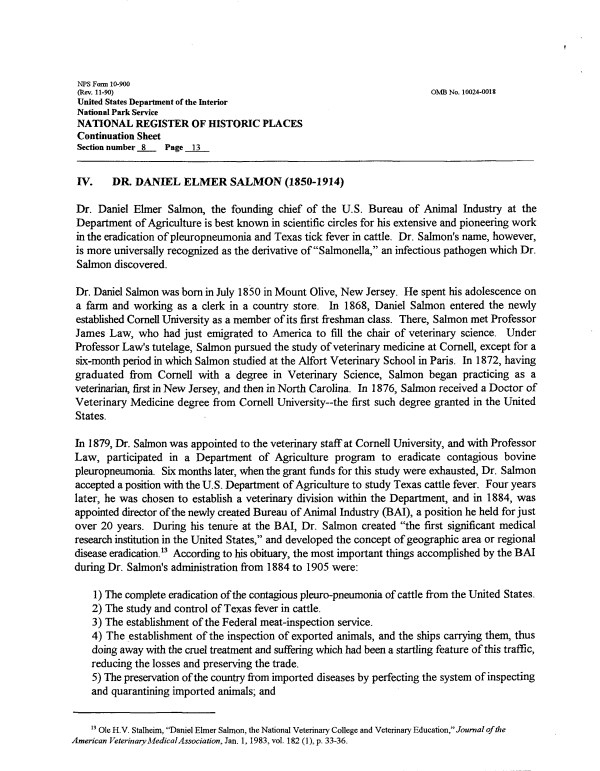 |
||||
|
DEPARTMENT OF HOUSING AND COMMUNITY DEVELOPMENT, MARYLAND HISTORICAL TRUST (Historic Sites Survey) var.d. MSA SE16-5 Image No: se16-5-0239 Enlarge and print image (73K) |
 |
||||
|
DEPARTMENT OF HOUSING AND COMMUNITY DEVELOPMENT, MARYLAND HISTORICAL TRUST (Historic Sites Survey) var.d. MSA SE16-5 Image No: se16-5-0239 Enlarge and print image (73K) |
| NFS Form 10-900 (Rev. 11-90) OMB No. 10024-0018 United States Department of the Interior National Park Service NATIONAL REGISTER OF HISTORIC PLACES Continuation Sheet Section number 8 Page 13 IV. DR. DANIEL ELMER SALMON (1850-1914) Dr. Daniel Elmer Salmon, the founding chief of the U.S. Bureau of Animal Industry at the Department of Agriculture is best known in scientific circles for his extensive and pioneering work in the eradication of pleuropneumonia and Texas tick fever in cattle. Dr. Salmon's name, however, is more universally recognized as the derivative of "Salmonella," an infectious pathogen which Dr. Salmon discovered. Dr. Daniel Salmon was born in July 1850 in Mount Olive, New Jersey. He spent his adolescence on a farm and working as a clerk in a country store. In 1868, Daniel Salmon entered the newly established Cornell University as a member of its first freshman class. There, Salmon met Professor James Law, who had just emigrated to America to fill the chair of veterinary science. Under Professor Law's tutelage, Salmon pursued the study of veterinary medicine at Cornell, except for a six-month period in which Salmon studied at the Alfort Veterinary School in Paris. In 1872, having graduated from Cornell with a degree in Veterinary Science, Salmon began practicing as a veterinarian, first in New Jersey, and then in North Carolina. In 1876, Salmon received a Doctor of Veterinary Medicine degree from Cornell University—the first such degree granted in the United States. In 1879, Dr. Salmon was appointed to the veterinary staff at Cornell University, and with Professor Law, participated in a Department of Agriculture program to eradicate contagious bovine pleuropneumonia. Six months later, when the grant funds for this study were exhausted, Dr. Salmon accepted a position with the U.S. Department of Agriculture to study Texas cattle fever. Four years later, he was chosen to establish a veterinary division within the Department, and in 1884, was appointed director of the newly created Bureau of Animal Industry (BAI), a position he held for just over 20 years. During his tenure at the BAI, Dr. Salmon created "the first significant medical research institution in the United States," and developed the concept of geographic area or regional disease eradication.13 According to his obituary, the most important things accomplished by the BAI during Dr. Salmon's administration from 1884 to 1905 were: 1) The complete eradication of the contagious pleuro-pneumonia of cattle from the United States. 2) The study and control of Texas fever in cattle. 3) The establishment of the Federal meat-inspection service. 4) The establishment of the inspection of exported animals, and the ships carrying them, thus doing away with the cruel treatment and suffering which had been a startling feature of this traffic, reducing the losses and preserving the trade. 5) The preservation of the country from imported diseases by perfecting the system of inspecting and quarantining imported animals; and 13 Ole H.V. Stalheim, "Daniel Elmer Salmon, the National Veterinary College and Veterinary Education," Journal of the American Veterinary Medical Association, Jan. 1, 1983, vol. 182 (1), p. 33-36. |